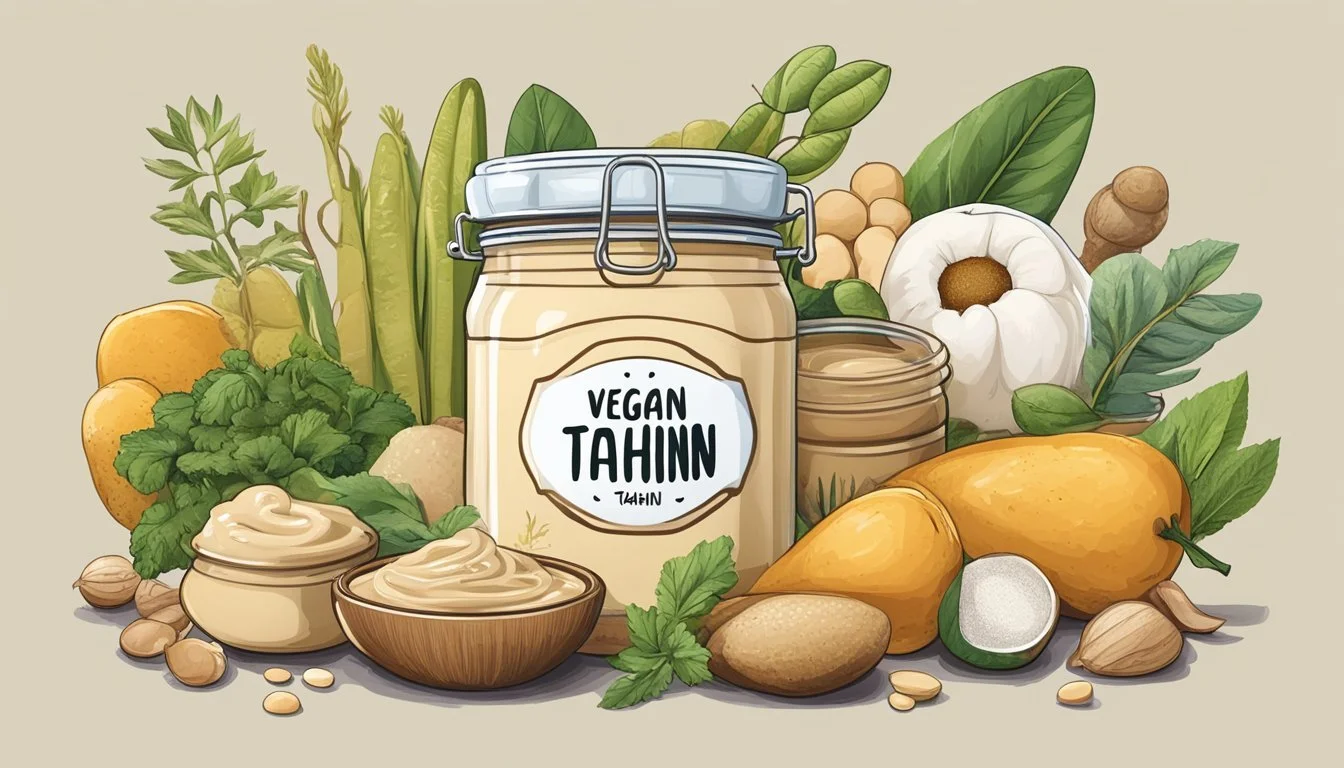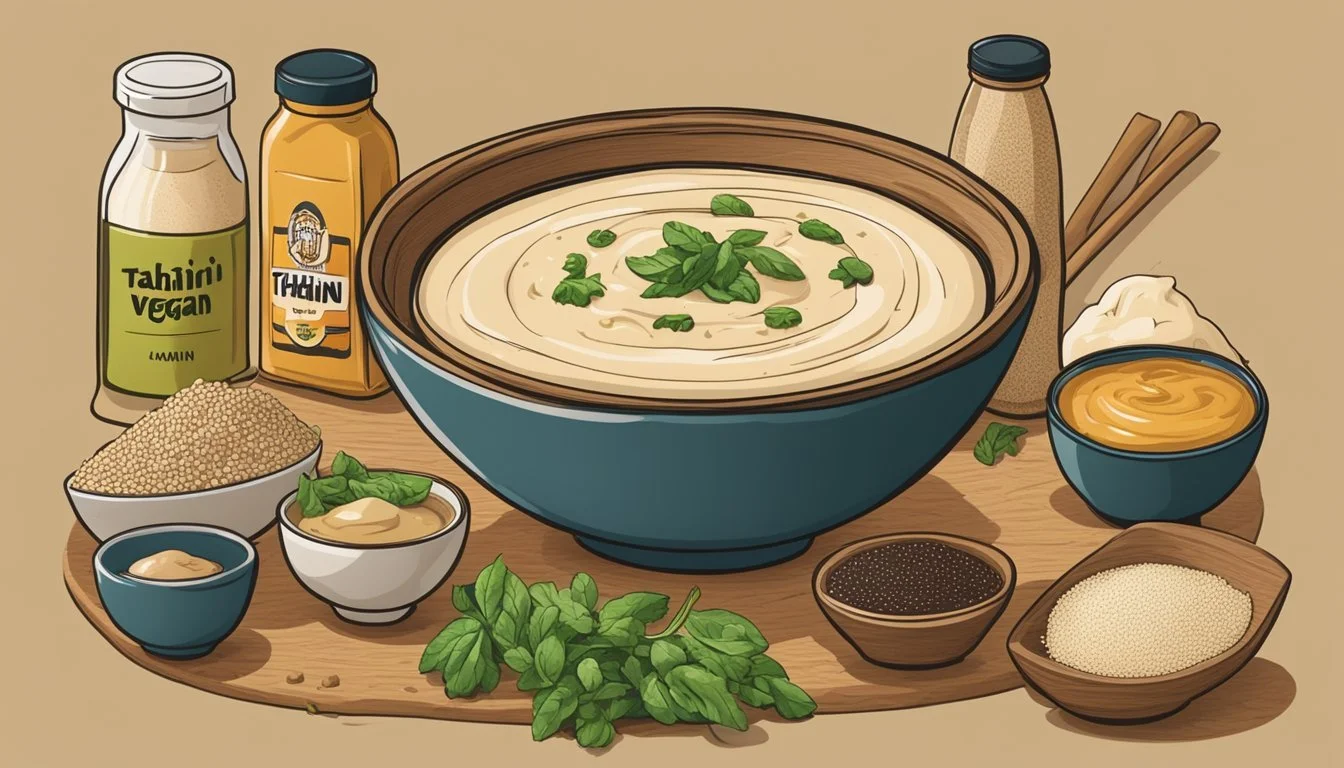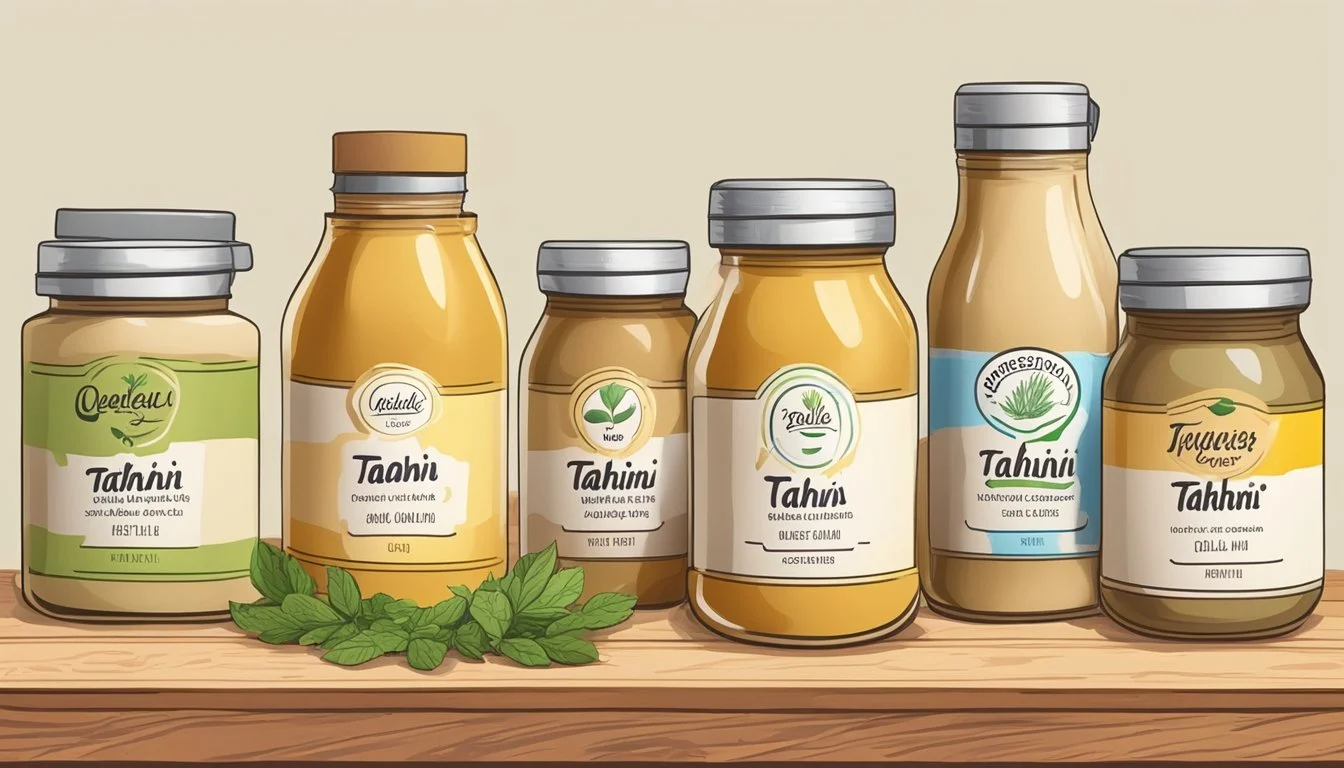Is Tahini Vegan?
Uncovering the Truth About This Sesame Paste
Tahini, a paste made from ground sesame seeds, is a staple in Middle Eastern cuisine known for its rich, nutty flavor and creamy texture. It plays a crucial role in an array of dishes, from dressings and sauces to dips like hummus. With the rise of veganism, many individuals are scrutinizing ingredients to ensure they meet vegan standards, which exclude all forms of animal exploitation and cruelty.
For those seeking to maintain a vegan diet, tahini is an excellent ingredient to incorporate into their culinary repertoire. As tahini is produced by grinding sesame seeds into a smooth paste, often with the addition of oil to achieve the desired consistency, it typically does not contain any animal products. This makes it inherently suitable for a vegan diet.
Furthermore, tahini is not only vegan but also offers health benefits due to its nutrient profile, including healthy fats, protein, and various minerals. Its versatility in the kitchen is evident as it enhances both savory and sweet creations, providing a subtle depth of flavor that complements various plant-based ingredients.
What Is Tahini?
Tahini is a sesame seed paste that is a staple in Middle Eastern cuisine, valued for its smooth texture and nutty flavor. It is primarily made from hulled sesame seeds, which may be roasted or raw before being ground into a paste.
Origin and Cultural Significance
Tahini has its roots in the Middle East, where it has been a culinary tradition for thousands of years. Its uses are ubiquitous in Middle Eastern dishes, often serving as a base for sauces, dressings, and dips. The paste has gained international acclaim, becoming a key ingredient in hummus and baba ganoush, and contributes to the distinct flavors associated with Middle Eastern cuisine.
Tahini Ingredients and Varieties
The core ingredient in tahini is sesame seeds. Typically, these seeds are hulled to remove the outer husk, leaving behind the softer and more palatable kernel. Tahini made from hulled seeds is usually smoother and has a more refined taste compared to its unhulled counterpart, which retains the husk and has a slightly bitter flavor.
Varieties of tahini can depend on the type of sesame seed used (white, black, or brown) and the addition of other ingredients such as:
Oil (for a more fluid consistency)
Salt (for seasoning)
Tahini's versatility extends to vegan diets where it provides a creamy texture and rich flavor without animal products.
Benefits of Tahini in a Vegan Diet
Tahini, made from ground sesame seeds, presents itself as a nutrient-dense food that is particularly beneficial in a vegan diet. It serves as a plant-based protein source and is rich in various nutrients that are essential for maintaining a healthy and balanced diet.
Nutritional Profile
Tahini's nutritional spectrum is impressive, making it a powerhouse in a vegan diet. A tablespoon of tahini typically contains:
Protein: about 2.6 grams, crucial for muscle repair and growth
Fiber: assists in digestion and promotes satiety
Unsaturated fats: including omega-3 and omega-6, which support heart health
Vitamins: especially B vitamins, which are vital for energy metabolism and brain function
Minerals: such as calcium and iron, which are often a point of concern in vegan diets
Health Benefits
The health benefits of including tahini in a vegan diet are numerous. The high levels of unsaturated fats contribute to cardiovascular health, while the protein content supports muscle and tissue repair. Additionally, the presence of fiber aids digestive health. Tahini is also abundant in minerals like calcium, which is integral for bone health, and iron, which is important for preventing anemia. The inclusion of B vitamins and other essential nutrients in tahini supports overall health and wellness, making it a beneficial addition to a balanced vegan diet.
Culinary Uses of Tahini
Tahini serves as a versatile ingredient in vegan cuisine, often used to create rich, creamy textures and enhance the flavor profile of dishes ranging from dips to baked goods.
Tahini as a Base for Dips and Sauces
Tahini paste, with its creamy consistency and nutty flavor, is a staple for creating a variety of vegan dips and sauces. Tahini sauce is a simple yet flavorful mixture often composed of tahini blended with lemon juice, garlic, water, and suitable seasonings for a balanced taste. This sauce can complement an array of foods, including vegan falafel and baba ghanoush.
Hummus, a classic Middle Eastern dip, fundamentally relies on tahini combined with chickpeas, lemon juice, and spices.
Vegan tahini sauce can also serve as a salad dressing, providing a creamy and nutritious alternative to dairy-based dressings.
For a quick and delicious dip, tahini can be mixed with herbs and spices, ideal for vegetable platters or as a spread for sandwiches.
Cooking and Baking with Tahini
When it comes to cooking and baking, tahini can be quite transformative. In its role as an ingredient:
Baking: Tahini can be incorporated into baked goods to add a subtle nuttiness and a moist texture. It's particularly effective in vegan recipes as a binding agent to create dense, flavorful pastries.
Cooking: Tahini used in savory applications can thicken sauces and stews, adding depth alongside a creamy component.
Furthermore, its ability to emulsify lends itself well to creating consistent, creamy pastes that enhance the body of a dish without the use of dairy, ideal for those adhering to a vegan diet. The addition of tahini in cooking is not just limited to Middle Eastern cuisine; it can be creatively applied across various culinary traditions.
Making Tahini at Home
Homemade tahini is a straightforward condiment to prepare, combining hulled sesame seeds and oil in a food processor or blender to create a creamy, versatile paste perfect for various dishes.
DIY Tahini Recipe
To make tahini at home, one will need a simple set of ingredients and a reliable kitchen appliance – either a food processor or a high-speed blender. Here's a step-by-step recipe:
Toast the Sesame Seeds:
Place hulled sesame seeds in a dry pan over medium heat.
Stir constantly until the seeds become lightly golden and release a nutty aroma, roughly 3 minutes.
Remove from heat and allow them to cool.
Blend the Seeds:
Transfer the cooled sesame seeds into a food processor or blender.
Pulse several times until a crumbly paste begins to form.
Add Oil and Other Ingredients (Optional):
While blending, slowly add oil to sesame paste. Start with 2 tablespoons of oil.
For flavor, one can add salt, garlic powder, or lemon juice as per their taste preferences.
Achieve Desired Consistency:
Continue to blend, adding more oil as needed.
For a creamier texture, one might need to add a bit more oil.
If the tahini is too thick, adding a small quantity of water can help achieve the right consistency.
Storage:
Transfer the tahini to an airtight container.
Homemade tahini can be kept in the refrigerator for up to a month.
Tips for Perfect Homemade Tahini
For the best homemade tahini, consider the following tips:
Sesame Seeds: Use high-quality hulled sesame seeds for a smoother tahini.
Blending: Begin at a lower speed and gradually increase it to prevent overheating the seeds.
Consistency Adjustments:
If the tahini is too thick, slowly blend in small amounts of water until the desired consistency is reached.
For a creamier texture, additional oil may be required.
Storage: Store tahini in an airtight container in the refrigerator to maintain freshness and prevent spoilage.
Store-Bought vs. Homemade Tahini
When considering tahini for a vegan diet, one must choose between store-bought and homemade varieties. Both options provide a plant-based source of nutrients, but they differ in preparation, ingredients, and nutritional values.
Pros and Cons
Homemade Tahini:
Pros:
Control over ingredients: One can ensure the use of high-quality sesame seeds and preferred oils like olive oil.
No additives: Homemade tahini typically contains no added sodium, sugars, or preservatives.
Cons:
Time-consuming: Requires sourcing sesame seeds and grinding them into a paste.
Inconsistent texture: Might not be as smooth as commercial brands.
Store-Bought Tahini:
Pros:
Convenience: Ready to use with a consistent quality.
Variety: Available in different brands, each with its distinct flavor profile.
Cons:
Potential additives: Some brands may include added sodium or preservatives.
Ingredient quality: Unable to verify the source and quality of sesame seeds used.
How to Choose a Quality Tahini
When selecting a tahini, whether store-bought or homemade, one should consider the following elements to ensure a quality product:
Ingredients List: Look for tahini with sesame seeds as the main ingredient, and avoid products with added saturated fats or sugars.
Oil Content: High-quality tahini should contain beneficial oils, such as olive oil, and should have a separation of oil at the top, indicating a natural product without emulsifiers.
Nutritional Profile: Compare the labels of different brands for nutrients and select one with lower sodium levels if keeping salt intake in check is a concern.
Taste and Texture: Personal preference will dictate the selection here; some may prefer the robust flavor of homemade tahini, while others may favor the smooth consistency of a store-bought jar.
When making tahini at home, it's recommended to use a neutral oil like olive oil to enhance the flavors while keeping the saturated fat content low.
Non-Culinary Uses and Trends
Tahini, recognized for its creamy texture and nutty flavor, has gained popularity beyond the kitchen, particularly in health and wellness communities and on social media platforms.
Tahini in Health and Wellness Communities
Health enthusiasts admire tahini for its high content of healthy fats, specifically monounsaturated fats. These fats are beneficial for heart health. Additionally, tahini is a good source of protein, making it a favorable option for plant-based diets. The versatility of tahini also allows it to be incorporated into various health-focused recipes such as energy balls, smoothies, and as a dressing for salads, contributing to a wholesome and nutritious diet.
Tahini Influence on Social Media
On platforms like Instagram and Facebook, tahini has become a trendy ingredient, with numerous users sharing their unique uses and recipes. Its visually appealing creamy quality enhances food photography, catching the eye of followers seeking new culinary inspirations. Users often boast about the ingredient's versatility, showcasing its applications in both sweet and savory dishes. The nutty flavor of tahini also makes it a popular topic among food influencers, who use it to add a special twist to traditional recipes.
Tahini Allergies and Dietary Considerations
Tahini is considered a safe and wholesome choice for those following a vegan diet as it lacks any animal products. However, when it comes to allergies and other dietary needs, there are some important considerations.
Nut and Seed Allergies
Individuals with allergies to seeds should approach tahini with caution, given that the core ingredient is sesame seeds. Sesame allergies are less common than nut allergies but can cause severe reactions in sensitive individuals.
Gluten-Free and Other Dietary Restrictions
Tahini is naturally gluten-free, making it a suitable option for individuals with celiac disease or gluten intolerance. As it is also dairy-free, tahini serves as an allergen-friendly flavor enhancer. Those with dietary restrictions, other than seed-related allergies, typically find tahini to be a versatile and beneficial addition to their diet.
Integrating Tahini into Various Cuisines
Tahini, a versatile condiment originating from Middle Eastern cuisines, has found its way into a variety of international dishes, enhancing the flavors of vegetables, salads, and proteins with its creamy, nutty profile.
Tahini Beyond Middle Eastern Cuisine
While traditionally associated with Middle Eastern cultures, tahini has crossed culinary borders, becoming a celebrated ingredient in Mediterranean and Asian dishes. It's effortlessly incorporated into Mediterranean recipes, often complementing the robust flavors of olive oil, lemon juice, and garlic. A spoonful of tahini can enrich the taste of a simple Greek salad or bring a new dimension to roasted vegetables like eggplant or zucchini.
Asian cuisine also embraces tahini, particularly in sauces and dressings that accompany tofu or steam-cooked veggies. Its presence in dipping sauces or as a component in a spicy noodle bowl highlights tahini's adaptability in a spectrum of culinary applications. The condiment's creaminess can balance the heat in Asian dishes while adding a subtle, nutty undertone.
Fusion Dishes and Innovative Pairings
Chefs and home cooks alike are getting creative with tahini, experimenting with fusion dishes that blend cultural flavors. Here are some innovative pairings:
Tahini Avocado Toast: A spread of tahini on toasted bread topped with slices of ripe avocado, a sprinkle of sesame seeds, and a dash of red pepper flakes.
Brussels Sprouts with Tahini: Roasted Brussels sprouts drizzled with a tahini-lemon sauce, uniting the bitterness of the sprouts with the smooth, rich taste of tahini.
Tahini-dressed Asian Salads: Crunchy Asian salads tossed with a dressing made from tahini, rice vinegar, soy sauce, and honey.
In summary, tahini's capacity to enhance a diverse range of dishes is limited only by the culinary imagination. Its health benefits and rich flavor profile make it a popular choice for those looking to explore new tastes while maintaining a wholesome diet.
Customizing Tahini for Unique Flavors
Tahini, made from ground sesame seeds, serves as a versatile base for a variety of flavors, both sweet and savory, which can be tailored according to individual tastes and culinary needs.
Incorporating Other Ingredients
To enhance the flavor profile of tahini, one can incorporate additional ingredients that complement its natural nuttiness. For a more savory edge, garlic powder and cumin are excellent choices, adding depth and warmth. Incorporating herbs such as cilantro or parsley lends a fresh, herby note to the mix. For those preferring a creamier texture, ingredients like peanut butter or blended cashews can be mixed into the tahini.
Sweet Variations:
Maple syrup: Imparts a rich, natural sweetness
Honey: Adds floral notes (note: using honey will not be vegan)
Sweet and Savory Variations
A balance of sweet and savory elements can create complex flavors within a tahini blend. For a hint of sweetness, one might add a touch of maple syrup, allowing for a subtle, natural sweetness without overpowering the tahini's inherent flavors. In contrast, a savory twist might involve a splash of lemon juice for acidity or miso for umami depth. Experimenting with spicy elements like sriracha can introduce heat, while a drizzle of canola oil in a preheated skillet can release the aromatic potential of the added spices and herbs, enriching the tahini’s flavor profile before combining it with the paste.
Tahini as Part of a Healthy Lifestyle
Tahini, a paste made from ground sesame seeds, is not only vegan but also a nutritious addition to a balanced diet. Its rich nutrient profile supports various health benefits important for maintaining a healthy lifestyle.
Weight Management and Energy
Tahini is a calorie-dense food, which means a small serving can provide a significant amount of energy. Its high calorie content comes from its fat content, with approximately 89 calories and 8 grams of fat per tablespoon. However, most of the fat in tahini is monounsaturated and polyunsaturated fatty acids, which are healthier fat varieties that can support weight management when consumed in moderation.
For those watching their intake, tahini can be an energy-boosting ingredient due to its combination of fat, protein, and carbohydrates. A tablespoon of tahini typically contains:
Calories: 89
Fat: 8g (Monounsaturated fat: 3.3g, Polyunsaturated fat: 3.5g)
Carbohydrates: 3g
Fiber: 1.4g
Protein: 2.6g
Incorporation into Daily Diet
Incorporating tahini into a daily diet is simple due to its versatile nature. It can be used as a spread, dressing, or dip, easily adding a creamy texture and nutty flavor to meals. Rich in essential vitamins and minerals, tahini offers significant amounts of magnesium, fiber, vitamin B1, and other nutrients vital for bodily functions.
Tahini’s nutrient content per 100 grams typically offers:
Magnesium: Important for bone health and energy production
Fiber: Aids in digestive health and can help with satiety
Vitamin B1: Crucial for converting food into energy
Vitamins and Minerals: Contributes to overall well-being with a range of micronutrients including phosphorus, manganese, and vitamin B6
When using tahini, individuals can benefit not only from its plant-based protein content, which supports muscle health, but also from its variety of nutrients that complement a vegan or vegetarian diet.









